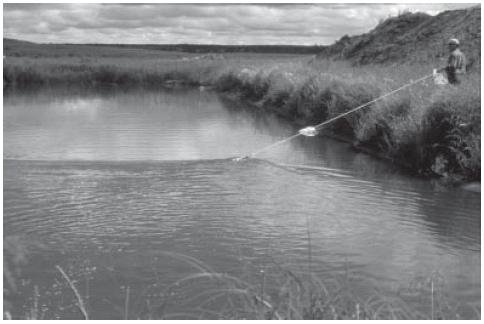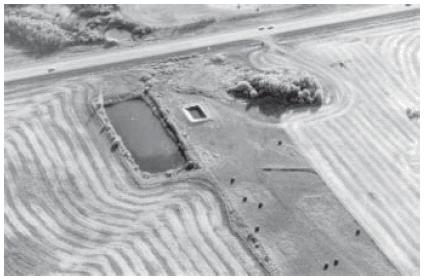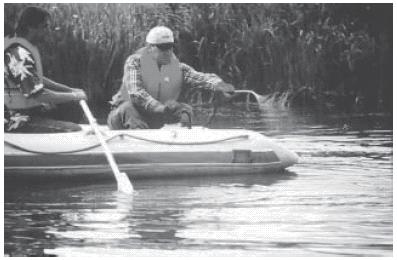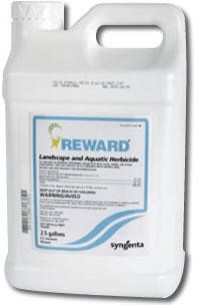The goal of dugout management is to protect and improve water quality. Some of the strategies for doing this through dugout location and design have been discussed in the Planning Module. This chapter provides suggestions for preserving and enhancing water quality in existing dugouts. The cost and effort to properly manage a dugout is generally small and most often rapidly recovered in the form of improvements in water quality. Improving water quality reduces treatment costs, improves productivity of livestock, and generally improves the quality of rural life.

At a minimum, dugouts need to be inspected weekly during April to September and monthly from October to March. Early detection of problems allows corrective action before water quality deteriorates significantly. When inspecting, look for:
Keep a record of your inspections. This will enable you to document and analyze both short-term and long-term occurrences. The following example, Figure 8-1, shows a filled out Dugout Maintenance Schedule. Review the example to see the type of information recorded. Use the blank form located in the pocket at the rear of the manual to record dugout inspections.
Dugout Management Practices.
There are a great number of dugout management practices. Many are known to be highly effective, others are still in the experimental stages. Some techniques are common sense and do not require special or highly processed products or services. Other treatments involve chemicals and make use of commercial products. This module outlines some of these practices, including their strengths and weaknesses.
Established practices
The practices presented in this module are well-established methods of greatly improving dugout water quality.
Continuous aeration- Continuous injection of supplementary oxygen is the single most effective practice for maintaining and improving water quality. Aeration is discussed further in Module 5 - Operating Systems, Dugout Aeration Systems.
Sediment removal - Excavation of accumulated sediment from a dugout, every five to ten years, is an effective technique for improving water quality and extending the life of a dugout. Unfortunately, it is costly and excavation may exceed the cost of new dugout construction. Make careful cost estimates prior to deciding to clean out a dugout. Where two or more dugouts exist, divert all runoff away from the dugout to be excavated. Let the dugout dry up during summer, and excavate the sediment in early fall. Where only one dugout exists, the only way to excavate sediment under water is with a dragline or hydraulic backhoe. After excavation under water, expect the water to have high turbidity for up to several weeks or perhaps months.

Vegetation control - Routine maintenance of the area around a dugout is important for maintaining water quality. Grassed buffers and runways surrounding dugouts should be mowed regularly. This prevents long grass from lying down and becoming ineffective as a sediment trap. Proper setback of shelterbelts ensures that the amount of fallen leaves entering the water is at a minimum. Steep end-slopes reduce the amount of emergent plants than can grow in the dugout. If possible, aquatic plants should be removed from the dugout before they die and decompose. Shrubs and trees will take root on the banks of the dugout. Left alone, they can grow quite large and contribute significant amounts of vegetation to the water in fall. Annual cutting and removing of willows and volunteer saplings every fall can make a significant contribution to protecting dugout water.
Removal of animals - Animals such as salamanders, also called mud puppies, and muskrats can create problems in a dugout by burrowing, house building, and foraging for plant roots. This disturbs the sediments and keeps the water constantly turbid. The most effective way to remove muskrats is trapping or hunting. Specially designed fencing can be used to keep them out in the first place.
Copper sulphate - Copper sulphate, also known as bluestone, is perhaps the most common chemical used to treat dugouts, as shown in Figure 8-2. It is also the least understood. Copper is an essential element for both plants and animals, but at high concentrations, it can be toxic. Copper treatments can be very effective at controlling cyanobacteria. However, copper sulphate treatments are most effective when done in early summer before large populations develop.
Copper may also kill beneficial organisms, like zooplankton, which feed on some algae species. Overuse and repeated treatments can also cause a buildup of copper in the sediments of a dugout. This can harm or kill beneficial organisms and disrupt the normal biology of the dugout.
In fact, a single overdose can also cause a man-made green algae bloom. Health Canada recommends that the concentration of copper in drinking water for humans not exceed 1 mg/L copper. However, this is far below what would be a toxic level.

Copper treatments should therefore be done very selectively. It is not reasonable to expect dugouts to be completely free of green or brown algae, nor free of aquatic plants. The primary target organism of a copper treatment is cyanobacteria. If copper is applied during an algae bloom, there may be an immediate release of large quantities of toxin. Because of the toxins they produce, it is recommended that you wait a minimum of 14 days before the water is used for human or animal consumption. This should allow toxin levels to dissipate. Continuous diffused aeration during this period may also help degrade toxins.Comment: Don't overdose! Copper is not effective on green algae!
Copper is found in a variety of products. The active ingredient is always the copper element (Cu) itself. Contact the Canada Pest Management Regulatory Agency for the copper products currently registered for the control of agae in dugouts.
Coagulation - As opposed to treating the entire dugout, it is more economical to treat the small volume of water required for high quality use in a specially constructed treatment cell, separate from the dugout as shown in Figure 8-3. However, coagulation chemicals have successfully treated entire dugouts and have remediated flood affected turbid dugouts. The addition of Powdered Activated Carbon has proven to be helpful for increased removal of dissolved organic matter, taste, and odour compounds. If a dugout is coagulated regularly, chemical residues should be monitored.
ModuleHerbicides- Some herbicides are registered for use by the Canada Pest Management Regulatory Agency to control aquatic weeds and algae. These compounds may only be used on privately owned reservoirs where water does not flow into other water bodies, as shown in Figure 8-4. Always follow label directions, and use safe handling practices to protect yourself from the product. In order to calculate the proper dosage, you must accurately estimate the existing volume of water in the dugout to be treated.
Herbicide Treatment
Reward herbicide is fast acting and broad spectrum on submersed weeds, especially effective on elodea, EurasianReward Herbicide. Can be Purchased at UFA.
Watermilfoil, coontail and duckweed. Recommended highly for ponds and along lakeshore areas. It is absorbed by target plants in just minutes with no toxicity to fish or wildlife. No Swimming Restriction.
Sample 148ft x 148ft Pond (.50 Acre) *Reward Examples:Sample 100ft x 100ft Lakeshore Lot (.23 Acre) *
Amount of Reward required : .46 Gal for Submerged weeds. 4 ft average depth.
Amount of Reward required: One Gal for Submerged weeds.
Water Use Restrictions: None on Swimming or Fishing. Irrigation 5 Days. Container Size: 1 Gal Jug or 2 1/2 Gal Jug Formulation: Liquid
*Consult Label for Exact Doses, Additional restrictions & Important Application Directions. Dose requirements are less for Duckweed control or shallow waters of less than 2 Feet. For Duckweed control the label recommends adding a non-ionic surfactant. One pint of DyneAmic Surfactant is typically enough for most projects. (See DyneAmic Surfactant)

